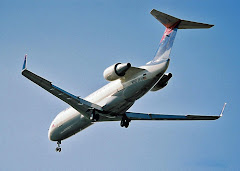5:18 AM - Thursday, Oct. 06, 2005
Simulator #1 -- Welcome to What Feels Like The Space Shuttle....
All of the studying and cramming, test taking and memorizing has culminated in our ability to finally get into the simulator. We had a 3-hour pre-briefing from 9pm to midnight and then got a feel for the plane (identical to the sim) from midnight to 0400. We finished up with a 30-minute debrief of the things we did well individually and as a crew, and the things we need to work on before tomorrow.
If you’ve never been around a full-motion Level D simulator, it’s hard to imagine what it’s like. Rumor has it the CRJ sims cost upwards of $20 million each. Should I win the megaball lottery it’s one of the first things I’ll buy! It’s about 2.5 stories tall and looks like a big bulbous pod on top of 8 hydraulic legs. Remember those giant “walking” robot-like things in the early “Star Wars” movies? The sims at Flight Safety (training company) are similar. They’re bolted to the concrete and have such accurate movements that both the students and the instructors must wear 5-point harnesses. When I was learning to fly the Citation, my first jet, I actually crashed so hard that my 60-some year old instructor fell out of his chair! They simulate such real flight that the FAA doesn’t care that our first flight in the actual physical airplane is one with 50 passengers in back! There is very little that can happen in the real world that the instructor can’t make happen in the sim. Icing, turbulence, windshear, icy runways, gusty cross-winds, single and multiple systems failures, lost communications, computer glitches, you name it.
The idea in the sims here at ASA is to train hard and test easier. As I said, every possible failure can be programmed into the sim, and a crash (not that I’d know!) actually hurts! Some crews mess up and get the “red screen of death”, but so far Steve and I have been spared that sight. But rather than let us get a feel for the plane and how it flies in our first night in “the box”, we were given system failure after system failure right after take off. Keith, our instructor, did allow us to keep both of our engines, but that’s the last flight for which that’ll be the case!
We got through the failures well, and are learning to do the proper things with the switches at the right times. It’s one thing to sit in the still and quiet of my hotel room, staring at a paper mock-up of the flight deck, and “push” the correct buttons in the correct order for each phase of flight. And it’s quite another to do it when there are noises and buzzers, lights and whistles going off. And to try to maintain control of the plane, while talking to air traffic control and trying to stay on course or fly an approach into an airport in bad weather. I can almost feel the new pathways being seared across my gray matter -- it’s definitely sensory overload!
Our instructor said we did very well tonight – well enough to get some extra time to fly around without the autopilot on. We practiced some straight and level flight, turns, climbs, descents, and experimenting with pitch and power, and how it feels when 30 degrees of flaps go out as opposed to 45. Or what happens with the lift when the spoilers are deployed. Just like every other airplane ever built it flies the same way aerodynamically. If you point the nose too high you’ll slow down and eventually stall the airflow over the wings (and in the case of the CRJ you’ll die). If you point the nose down too far, you’ll speed up beyond the limitations of the structure and potentially rip off your wings. But the CRJ was built by those kind Canadians in order to be flown by a crew of trained idiots, really. It’s such an automated, dummy-proof airplane that with enough training and practice anyone could learn to fly it. Not that it’s easy at all, but it’s logic makes sense and it handles well. It’s so automated and so redundant that it’s a pleasure to fly and it’s easy to learn to trust.
Thankfully Steve and I have the benefit of my previous jet experience, and my previous type rating training in the Citation. I learned how to study effectively and we’ve spent a lot of hours together on the ground learning this stuff. It’s hard to believe that we’ll only have 8 sim sessions before our checkride (which is in 3 weeks!), but they have a 90-some percent pass rate. Amazing, really. Mind-boggling.
It’s still a bit hard to adjust to the vampire hours. We’ve been so used to getting up at the crack of dawn for the last 6 weeks that it’s tough to sleep enough during the day to be awake until the sun nearly rises again! But the room has dark curtains and Em the cat is thrilled to spend as much time curled up with her momma, no matter what time of the day it is! And Ambien is a beautiful thing….
So, each night we will continue to have the kitchen sink thrown at us, over and over, making us faster and more accurate. The learning is manageable in content (barely), but we worry about the amount of stuff that’s got to get into our brains and stay there. It’s the staying there that’s the tricky part lately! It’s like the more stuff that goes in, the more stuff that falls out. I swear I wake up with entire paragraphs and colorful schematics lying on my pillow….








No comments:
Post a Comment